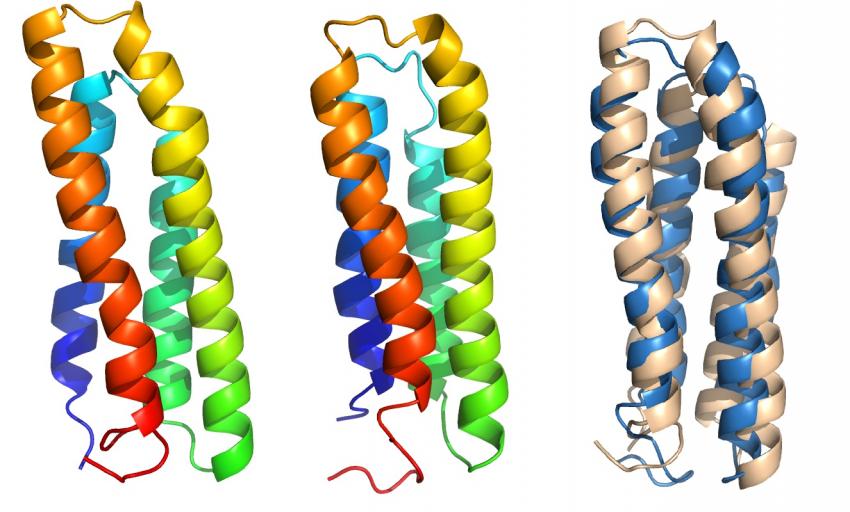|
||||||||||||
| 购买进口仪器、试剂和耗材——就在始于2001年的毕特博生物 www.bitebo.com |
无血清培养基UltraCULTURE Serum-free Medium网址链接http://www.bitebo.com/a/gb2312/gongsixinxi/shichanghuodong/2014/0514/5157.html  图片来源: Bobby Kim/莱斯大学 膜蛋白对于光合作用、视觉等功能至关重要。它们还是细胞的看门人,能决定什么可能会通过细胞膜,也帮助从细胞膜外部输入养料和将内部垃圾输出。由于这些多重角色,它们构成了很大一部分的药物靶点。虽然它们的功能很明确,但是关于它们如何折叠的信息却远远落后于球状蛋白质。 Wolynes及其同事使用原始的基因组信息,来预测氨基酸链将如何通过遵循阻力最小的途径(取决于链上每个残基相关的能量),折叠成为功能蛋白质。一个蛋白质越接近于其功能性“原始”状态,它就会越稳定。Wolynes的开创性理论生动地将这种能量描绘成一个漏斗。 为了检测他们的计算机模型,研究人员将它们与X射线晶体学获得的真实蛋白质结构进行比较。大量的结构对球状折叠的蛋白质是可用的,这些蛋白漂浮在体内,执行生命必不可少的任务。 但直到最近几年,我们已经很难获得跨膜蛋白的相似结构,因为要提取它们用于成像,同时又不会破坏它们,难度非常的大。最近有研究人员利用一种去垢剂洗掉目的蛋白上的大多数膜,Wolynes称:“它在蛋白质周围留下一个脂肪层,但是却给出一种涂层,可使整个分子在后来形成晶格。” 当Wolynes注意到,两种广泛使用的细胞生物学教材对于跨膜蛋白如何折叠有完全不同的意见时,受到启发研究膜蛋白。他说:“其中一本教材,列出所有规则,说:‘这是证据表明,它是动力学控制的。’另外一本教材指出:‘这是证据表明,它是热力学控制的。’它们以那种方式被写入教材,好像是绝对确定。我想说我仍然不确定,但我认为我们的工作更多地指出,折叠是热力学(平衡)控制的,至少一次蛋白质是停留在膜中。” Kim和Schafer修改了Wolynes实验室使用的一种蛋白质折叠算法,被称为联想记忆、水介导的结构和能量模型(AWSEM),来解释膜蛋白所特有的外界影响,包括将部分折叠蛋白质插入膜的易位子机制和膜本身。 利用这种算法,他们成功地确定,热力学漏斗在膜蛋白折叠中似乎仍然占据上风,如同它们为球状蛋白质所做的。 Kim称:“我们有来自许多不同实验室的膜蛋白结构数据库,我们能了解在它们之间转换的参数。这些参数指定两个残基(珠)应该相互作用的多么强烈,并考虑周围的环境。这可让我们能够从原始序列做出预测。” 随着越来越多的结构变得可用,研究人员希望调整AWSEM膜算法。Wolynes说:“我不认为我们已经了解膜的相互作用。”这表明大部分的漏斗形折叠发生在蛋白质进入膜之后,很少是因为疏水性(动力学)相互作用,疏水性相互作用在球状蛋白质折叠中发挥了更大的作用。他说:“我的直觉是,那将是正确的。” Wolynes说:“本文的意义在于,现在我们有一种运算法则,可根据原始的基因组序列,相当好地预测膜蛋白结构。这对于解释新一代的实验结果将非常的有用。” 原文摘要: Predictive energy landscapes for folding α-helical transmembrane proteins Bobby L. Kim, Nicholas P. Schafer and Peter G. Wolynes We explore the hypothesis that the folding landscapes of membrane proteins are funneled once the proteins’ topology within the membrane is established. We extend a protein folding model, the associative memory, water-mediated, structure, and energy model (AWSEM) by adding an implicit membrane potential and reoptimizing the force field to account for the differing nature of the interactions that stabilize proteins within lipid membranes, yielding a model that we call AWSEM-membrane. Once the protein topology is set in the membrane, hydrophobic attractions play a lesser role in finding the native structure, whereas polar–polar attractions are more important than for globular proteins. We examine both the quality of predictions made with AWSEM-membrane when accurate knowledge of the topology and secondary structure is available and the quality of predictions made without such knowledge, instead using bioinformatically inferred topology and secondary structure based on sequence alone. When no major errors are made by the bioinformatic methods used to assign the topology of the transmembrane helices, these two types of structure predictions yield roughly equivalent quality structures. Although the predictive energy landscape is transferable and not structure based, within the correct topological sector we find the landscape is indeed very funneled: Thermodynamic landscape analysis indicates that both the total potential energy and the contact energy decrease as native contacts are formed. Nevertheless the near symmetry of different helical packings with respect to native contact formation can result in multiple packings with nearly equal thermodynamic occupancy, especially at temperatures just below collapse.
无血清培养基UltraCULTURE Serum-free Medium网址链接http://www.bitebo.com/a/gb2312/gongsixinxi/shichanghuodong/2014/0514/5157.html |
购买进口仪器、试剂和耗材——就在始于2001年的毕特博生物
www.bitebo.com |
|